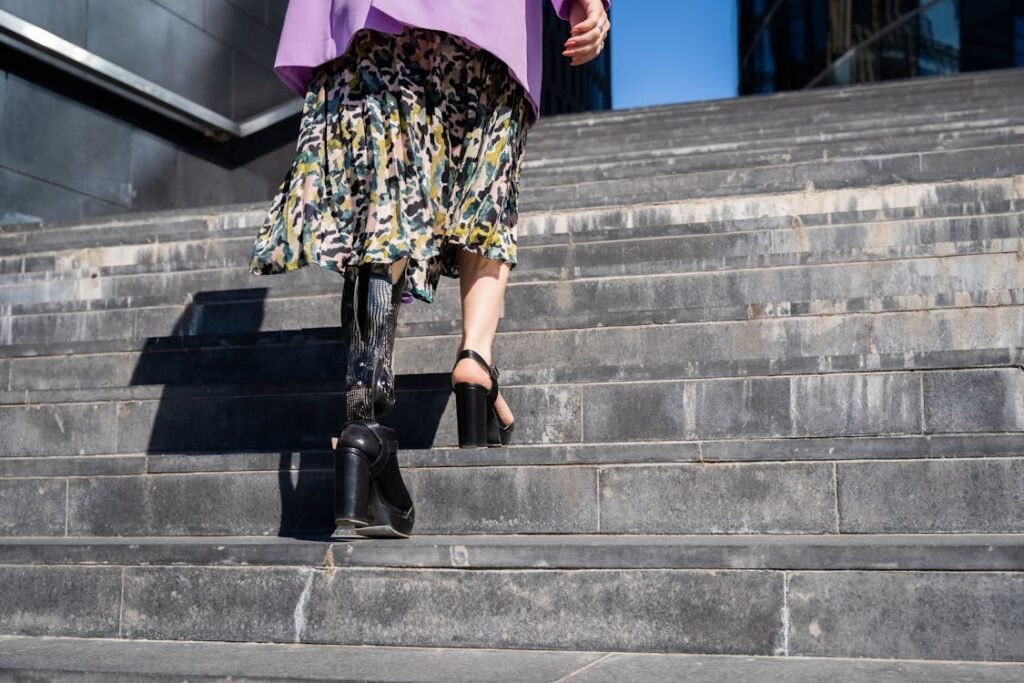Walking with a prosthesis should feel smooth and balanced. But for many prosthetic users, the reality is often different. Sometimes the steps feel uneven. The movement feels forced. There may be pain, instability, or just a sense that something isn’t right. These are signs of gait deviations—small changes in the way you walk that, over time, can lead to discomfort, fatigue, or even injury.
The good news is that most gait problems can be fixed. With the right guidance, a careful look at your walking pattern, and a few practical changes, you can improve your gait and feel more comfortable in your prosthesis. At Robobionics, we’ve worked with thousands of prosthetic users who’ve struggled with these issues. We know what it takes to get back on track.
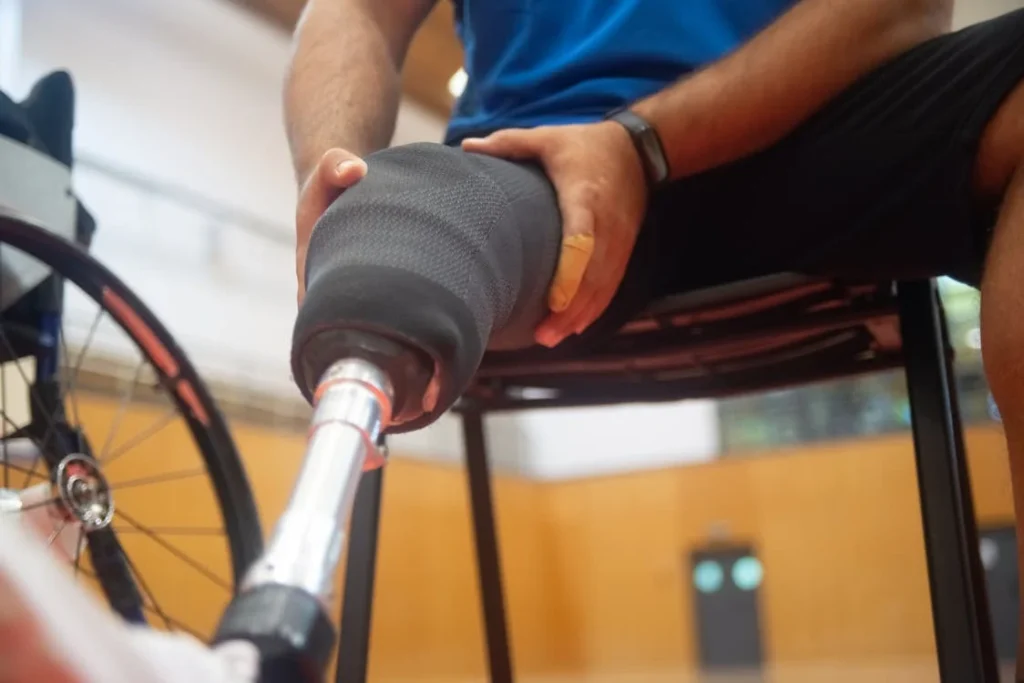
Understanding Gait Deviations
Gait deviations happen when your walking pattern changes from what is considered normal or balanced. These changes might be hard to notice at first. Maybe one foot lands louder than the other.
Maybe your shoulders shift slightly, or your hips move unevenly. These small signs are important. They’re often the body’s way of compensating for something—whether it’s pain, weakness, poor alignment, or an issue with the prosthesis.
For prosthetic users, gait deviations are common, especially in the early stages of rehabilitation. When you lose a limb, your whole body adjusts. Muscles that were once strong may become weaker.
Your brain has to relearn how to walk using new information from your prosthetic side. Sometimes, your socket might not fit well, or your limb might change shape slightly. All these things can affect how you walk.
What’s important to understand is that gait deviations are not a sign of failure. They’re signals. They’re telling you that something needs attention.
And when you catch them early, they’re much easier to fix. That’s why being aware of your gait is the first step to improvement.
Why Gait Deviations Happen
There are many reasons why your gait may change. One of the most common is poor prosthetic alignment. If your prosthesis is not set up at the right angle or length, it can cause you to lean too far forward or backward.
This puts pressure on your joints and can lead to pain or injury. Another reason might be muscle weakness. After an amputation, it takes time to rebuild strength in the hips, thighs, and core. Without that strength, your body may struggle to keep balance.
Pain can also cause gait deviations. If your socket is rubbing, pinching, or putting pressure on a sensitive area, you might shift your weight to avoid discomfort.
Over time, this becomes a habit, and the way you walk changes. Even fear can play a role. Some users are afraid to put full weight on the prosthetic leg, especially in the beginning. This causes them to favor their sound leg, which throws off balance.
Sometimes, the problem is with the prosthesis itself. It may be too loose or too tight. The foot may be too stiff or too soft. Even small differences in how the prosthesis is adjusted can have a big impact on your gait.
That’s why regular follow-ups with your prosthetist are so important. A minor tweak in alignment or socket fit can make a world of difference.
The Most Common Gait Deviations in Prosthetic Users
One of the most frequent issues is called “vaulting.” This happens when you lift your body unnaturally high to swing your prosthetic leg forward.
It usually means your prosthesis is too long or you’re not bending your knee enough. Vaulting can make walking tiring and may lead to pain in your hip or lower back.
Another common deviation is “circumduction,” where you swing your prosthetic leg out in a wide arc instead of straight forward.
This can happen if your prosthetic knee doesn’t bend easily or if your hip is weak. It often starts as a way to make walking easier, but over time it becomes inefficient and awkward.
“Uneven step length” is also very common. This is when one step is shorter than the other. Usually, the step with the prosthetic leg is shorter because the user doesn’t feel confident enough to roll over the toe. It can also happen when the sound leg is doing more work than it should.
Some people experience a “hip hike,” where they lift their hip on the prosthetic side just to get the foot off the ground.
This can be a sign of poor prosthetic alignment, limited knee motion, or poor muscle control. It may feel like a shortcut, but it adds extra stress to your spine.
These deviations may seem small, but over time they can lead to pain, joint wear, and frustration. Fixing them starts with understanding what’s causing them and how your body is reacting.
How to Start Fixing Gait Deviations
The first step to fixing any gait deviation is awareness. That means paying attention to how you walk. Ask someone to record you walking from different angles.
Watch the video carefully. Do your steps look even? Are your shoulders and hips level? Is your head upright, or are you looking down? Sometimes, just seeing your walk can reveal problems you didn’t feel.
Next, talk to your physical therapist or prosthetist. They have the training to spot even the smallest issues. They’ll guide you through exercises and adjustments designed to correct the problem.
In some cases, your prosthesis may need realignment. In others, you may need to strengthen specific muscles. Often, it’s a combination of both.
Small changes can go a long way. Practicing weight shifting exercises can help you trust your prosthetic side more.
Core strengthening can help you stay upright and balanced. Walking slowly and mindfully can help your body relearn the right patterns.
It’s also important to wear the right shoes. Shoes that are too soft or too stiff can affect how your prosthesis works. Choose shoes that offer good support and keep the heel height consistent. This helps keep your body in alignment.
Fixing gait deviations takes time, but the effort is worth it. Each step you take in the right direction makes walking easier, safer, and more natural.
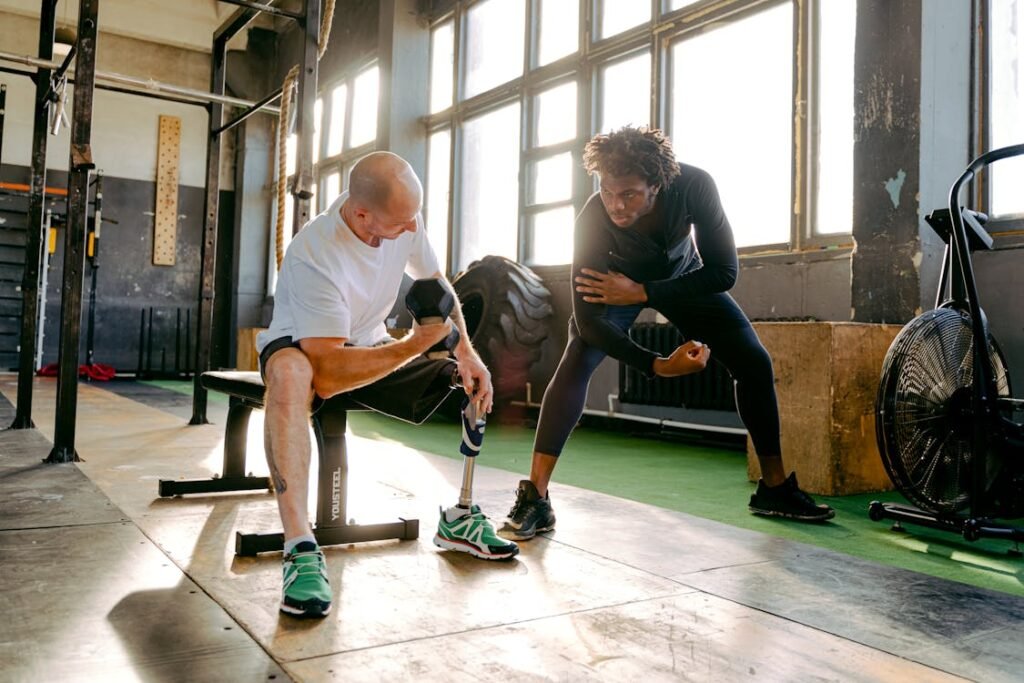
Strengthening the Body to Support Better Gait
To fix gait deviations, your prosthesis must be well-fitted and aligned, but just as important is your body’s strength and control. Without strong muscles to support you, even the best prosthesis can’t help you walk well.
That’s why a big part of correcting gait deviations involves strengthening the right areas—especially your hips, thighs, glutes, and core.
When these muscles are weak, your body finds ways to compensate. You might lean forward too much, swing your leg out to the side, or lock your knee to avoid instability.
These are all signs that your body is trying to find balance the wrong way. But by working on strength and control, you can train your body to find balance the right way.
Start by focusing on your hips. Your hip muscles keep your pelvis level when you walk. If they’re weak, your pelvis may drop on one side, which causes your entire body to tilt.
This leads to back pain, uneven steps, and a higher risk of tripping. Simple exercises like standing leg lifts, side-lying raises, or even slow step-ups can help strengthen the muscles that hold your hips steady.
Your glutes—the muscles in your buttocks—are also crucial. They power your steps and help control your leg as it swings forward and backward. If they’re not strong, walking becomes less efficient.
That’s when you start to feel tired after just a short walk. Strengthening your glutes gives your gait more power and control, which reduces strain on the rest of your body.
Then there’s your core. Many people think the core is just the stomach muscles, but it’s much more than that. It includes the muscles around your spine, your pelvis, and even the lower part of your ribs.
A strong core helps you stay upright and steady. It prevents you from leaning too far forward or side to side. Simple exercises like seated balance drills, pelvic tilts, or holding a position on one leg can help engage your core gently but effectively.
And don’t forget your remaining leg. Many prosthetic users unknowingly put too much pressure on their sound leg, which makes it do more than its share.
Over time, this can cause fatigue and joint pain. Strengthening that leg—while also making sure your prosthetic side stays active—is essential for keeping your gait even.
The key to all of this is consistency. You don’t need to do heavy workouts or complicated routines. Just a few targeted movements each day, with a focus on control and form, can bring noticeable improvements.
Training Your Brain as Much as Your Body
While physical strength is vital, gait is also controlled by your brain. When you walk, your brain processes signals from your muscles, joints, eyes, and ears.
It uses that information to keep you balanced and moving in the right direction. But after an amputation, your brain has to relearn how to walk with a prosthesis. That takes time, and it’s not just about muscle memory—it’s about new pathways being built in your brain.
This process is called neuroplasticity. It means your brain can change and adapt based on new experiences. Each time you practice a movement the right way, your brain gets better at sending the correct signals.
That’s why slow, focused practice is so important. When you walk with full attention—thinking about each step, each shift in weight, each swing of the arm—you’re helping your brain form better connections.
That’s also why it’s better to walk correctly for a short distance than to walk incorrectly for a long one. Quality over quantity matters here. Every good step is a teaching moment for your brain. Over time, what feels hard at first becomes automatic.
Your therapist may use tools like mirrors or even video to help you see how you’re walking. Watching yourself helps connect what you feel to what’s actually happening.
You may also try walking while counting or repeating a rhythm in your head. These techniques help your brain time your steps more evenly.
Another helpful method is walking in different environments. Grass, carpet, concrete, ramps, and uneven paths all challenge your balance in different ways.
Each time you walk on a new surface, your brain learns to adjust. These experiences help you build more control and confidence.
Staying Patient Through the Process
Fixing gait deviations isn’t always fast. Some patterns may have formed months ago, and changing them takes more than just one adjustment or one exercise. It takes repetition, patience, and a bit of trust—in your body and in the process.
There may be days when your gait feels smooth and balanced, and then days when everything feels off. That’s normal. Progress is rarely a straight line. What matters is staying consistent and listening to your body.
If something feels wrong—sharp pain, swelling, or discomfort in the socket—don’t push through it. Talk to your prosthetist or therapist. Sometimes, fixing a gait issue is as simple as adjusting a socket or changing a foot component. Ignoring discomfort only leads to bigger problems later.
Celebrate the small wins. Maybe your steps are a little more even today. Maybe you walked a little farther without needing to stop. These are signs that your gait is improving. And every bit of progress adds up.
It’s also okay to ask for help. No one fixes their gait alone. Your prosthetist, your therapist, and even other amputees can offer insight and encouragement.
Sharing what you’re going through, asking questions, and being open to feedback makes the process smoother.
At Robobionics, we always remind our users that fixing gait is about more than walking better—it’s about living better.
When your steps are balanced, your energy lasts longer. Your pain goes down. Your confidence goes up. And that opens the door to more freedom in your life.
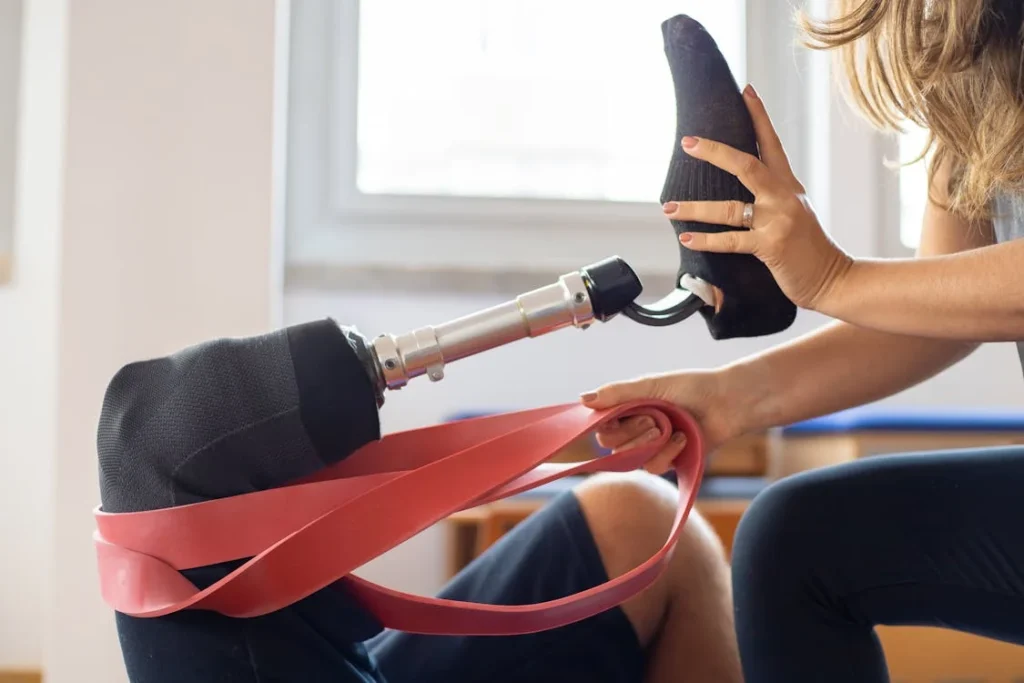
Realigning the Prosthesis for Better Gait
When it comes to fixing gait deviations, exercises and muscle strength are vital, but they aren’t the whole picture. Your prosthesis itself must work with your body—not against it.
If it’s even slightly misaligned, your gait will be off, no matter how strong or balanced you are. That’s why regular adjustments and checkups with your prosthetist are just as important as your daily exercises.
Alignment refers to the exact position of the socket, knee, and foot in relation to your body. Think of it like the tires on a car. If even one tire is turned the wrong way, the car won’t drive smoothly.
You’ll feel pulling, resistance, and uneven wear. Your body is the same. When your prosthesis is set at the wrong angle or height, it causes certain muscles to work harder than others. Over time, this leads to fatigue, pain, or even injury.
One clear sign of poor alignment is consistent discomfort during walking. Maybe your lower back hurts after just a few steps.
Maybe your foot slaps the ground loudly, or your knee locks at the wrong time. These are all clues that something isn’t quite right with your setup.
Another sign is visual asymmetry. If one shoulder sits higher than the other, or if your head tilts slightly while walking, these small posture changes can be linked to a misaligned prosthesis.
You may not feel the shift, but a therapist or trained prosthetist can spot it during gait observation.
Adjustments to the prosthesis are very precise. Your prosthetist might move the socket a few millimeters forward or backward, or adjust the angle of the foot.
These small changes can have a huge impact. Suddenly, your steps feel smoother. You’re not fighting your prosthesis anymore—you’re working with it.
Some prosthetic users feel nervous about getting adjustments. They worry that changes will make things worse, not better. But the truth is, your prosthesis should change with you.
As your body heals, strengthens, or shifts, your setup needs to match. You’re not stuck with the alignment you had on day one. In fact, most users need at least a few tweaks over the first year—and sometimes even beyond that.
Communication is key. Tell your prosthetist exactly what you’re feeling and when. Is the pressure worse in the morning? Does your knee feel unstable on stairs? Does your foot feel too far forward? These details help them understand how your prosthesis is interacting with your body and how to fix it.
At Robobionics, we always encourage our users to treat their prosthetic alignment like a partnership. When your body changes, your device should adjust. Keeping that relationship in tune leads to a smoother, more natural gait.
Relearning Walking Patterns One Step at a Time
Once your prosthesis is aligned properly, your body still needs time to relearn the correct walking pattern. That’s because your body may have developed habits to compensate for poor alignment before it was fixed. These habits can stick even after the physical issue is resolved.
To relearn the right pattern, it helps to break the walking cycle down into smaller pieces. Instead of focusing on the entire walk, you work on each phase: heel strike, mid-stance, toe-off, and leg swing.
By slowing down and practicing these parts individually, your brain starts to rebuild the correct movement.
One technique that helps is “mirror walking.” This means walking slowly while watching yourself in a mirror. You’re looking for symmetry. Are your shoulders level? Do your knees bend at the same time? Are your arms swinging evenly?
Mirror feedback is powerful because it gives you immediate visual information. When you see yourself moving unevenly, you can stop, reset, and try again.
Another effective method is walking with verbal or rhythmic cues. Saying “heel, toe” out loud or stepping to a beat helps you time your steps more evenly.
Some therapists use metronomes or music with a steady rhythm to train timing. These cues engage your brain and make the movement feel smoother.
Walking on different surfaces can also speed up the relearning process. Start on flat ground. Then try grass, carpet, or slightly uneven paths.
Each surface challenges your muscles in a different way and forces your brain to adapt. Over time, this helps you walk more naturally, no matter where you are.
Practice is essential, but practice without awareness doesn’t help. You have to focus. Mindless walking just reinforces bad habits. Mindful walking—where you feel each step and correct as you go—is what creates lasting change.
Long-Term Habits to Keep Your Gait Healthy
Once your gait starts to feel balanced and smooth, it’s important to keep it that way. That means turning what you’ve learned into habits that stay with you in daily life.
The goal is not just to walk well during therapy sessions, but to walk well always—at home, outside, at work, and in every moment of your day.
One habit is regular self-checks. Take a moment each day to check your posture in the mirror. Are your shoulders straight? Is your head up? Do you feel equal weight on both legs? These quick check-ins help you spot issues before they become patterns.
Make strength training part of your weekly routine. Even after your official therapy ends, continue with simple exercises. Keep your core strong, your hips stable, and your glutes engaged. These muscles are your foundation. When they’re strong, your gait stays steady.
Wear shoes that support your prosthesis. Keep the heel height consistent. Avoid overly soft soles that make you unstable or stiff shoes that limit your ankle’s ability to move. A good pair of shoes can protect your alignment and reduce strain on your joints.
Stay active. The more you walk, the more your gait improves. Movement keeps your muscles engaged and your brain connected to the right patterns.
But remember—quality is more important than quantity. Don’t rush or push yourself into pain. Walk with control and purpose, even if it’s just around your house.
Keep in touch with your prosthetist. Schedule regular checkups, even if everything feels fine. Your limb may change shape slowly, and catching those changes early prevents discomfort. A quick socket adjustment can help you stay aligned and comfortable.
Most importantly, listen to your body. If something feels different, don’t ignore it. Pain, fatigue, or even a strange sound from your prosthesis can be the first sign of a problem. Addressing it quickly keeps you on track and avoids long-term issues.
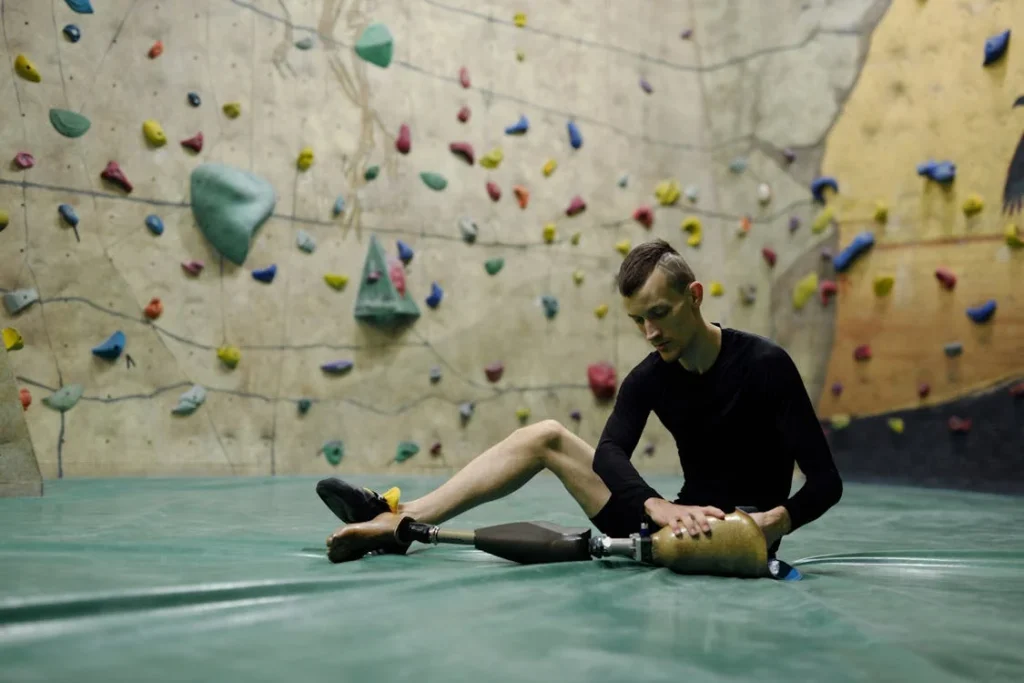
The Emotional Impact of Gait Deviations and How to Overcome It
Walking isn’t just a physical act. It’s emotional, personal, and deeply tied to how we see ourselves. When gait deviations occur—when walking doesn’t feel smooth, balanced, or natural—it doesn’t only affect the body.
It can shake your confidence, cloud your mindset, and impact your social life in subtle but powerful ways.
Many prosthetic users won’t talk openly about this, but the emotional weight of walking differently is real. You may feel self-conscious when you’re out in public.
Maybe you’ve noticed people looking at your gait, or perhaps you’ve caught yourself comparing how you walk to others. Even without anyone saying a word, you begin to feel judged—by others, or worse, by yourself.
This emotional layer is important to address because it directly influences recovery. When you feel unsure about your walk, you might avoid going out. You might take fewer steps during the day.
That means fewer chances to improve your gait and more chances for those deviations to stick around. Over time, a small issue becomes a major limitation—not because your body couldn’t adapt, but because your confidence didn’t keep up.
At Robobionics, we’ve seen this pattern many times. A user walks well in a clinic but tenses up the moment they step into a public setting.
Their steps change. Their posture tightens. They lose rhythm. Not because they aren’t capable, but because anxiety enters the picture.
Rebuilding Confidence, One Step at a Time
The first step to healing the emotional side of gait deviations is acknowledging that it’s valid. You’re not overreacting. You’re not being too sensitive. If your gait feels off and it’s bothering you, that feeling matters.
Start small. Practice walking in safe, quiet environments that don’t trigger anxiety. A quiet park. A wide hallway. Your living room.
Focus on smooth steps, relaxed arms, and steady breathing. The more you practice walking without pressure, the more those healthy patterns take root.
Then slowly introduce new environments. Don’t rush. Choose one new place at a time. Maybe it’s a nearby shop or a friend’s house. Walk in, move around, and leave.
The goal isn’t distance—it’s comfort. It’s about proving to yourself that you can walk well, even in new spaces.
Another helpful approach is walking with someone you trust. A friend, a spouse, a sibling—someone who supports you without judgement.
When you’re with someone who believes in you, your mindset shifts. You stop thinking about what others might see, and you focus on your movement.
If possible, talk to other prosthetic users. Hearing their stories helps you realize you’re not alone. Many have gone through the same doubts, faced the same looks, and come out stronger.
Their journeys can give you courage and perspective.
Your Gait is Not Your Worth
A key mindset shift is understanding that your gait does not define your value. Everyone walks differently—even people with two natural limbs.
Some people limp. Some shuffle. Some lean. The idea of a “perfect gait” is more about how it feels than how it looks.
Your gait is something you improve for you—for your comfort, your health, your freedom. It’s not for show. You’re not performing for anyone.
The smoother your walk feels to you, the more confident and comfortable you’ll be. And that’s what matters most.
When you stop tying your identity to how you look when you walk, the emotional pressure starts to lift. You begin to move freely, naturally—even if the gait isn’t flawless.
Ironically, this freedom often leads to better walking, because your body is no longer stiff with worry.
Celebrating the Emotional Wins
Progress in gait training isn’t just physical—it’s emotional too. The first time you walk across a room without looking down. The first time you forget you’re wearing a prosthesis while talking to a friend.
The first time you walk into a store and don’t notice anyone looking. These are victories. They matter. They deserve to be celebrated.
Keeping a simple journal can help. At the end of each day, write down what went well. Maybe you walked more steps than yesterday.
Maybe you walked in a crowded space and stayed relaxed. Maybe you smiled while walking—really smiled. These moments tell the true story of your progress.
And if you have a bad day? That’s okay too. Progress is not a straight line. Don’t let one tough moment erase all the effort you’ve put in.
One misstep doesn’t undo all the good steps. Be kind to yourself. You’re learning. You’re growing. You’re adapting.
Walking with Self-Belief
The path to correcting gait deviations isn’t just about fixing form or adjusting sockets. It’s also about building belief in your own ability. When you trust your body—and trust yourself—you walk taller, move stronger, and feel better.
Your walk is yours. Own it. Whether it’s perfectly balanced or still a work in progress, it represents your resilience, your effort, and your determination.
And that is something to be proud of.
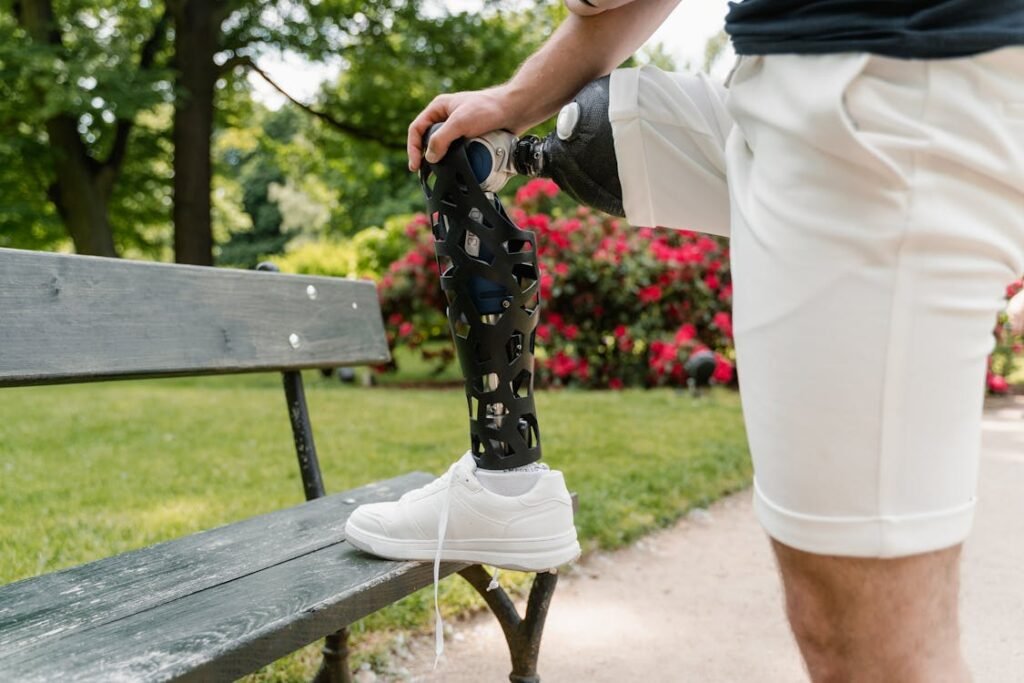
The Role of Daily Routines in Correcting Gait Deviations
Most people think that fixing gait deviations happens only in the clinic—during therapy sessions, strength workouts, or prosthetic adjustments.
But what many don’t realize is that your daily routine plays an equally important role. The way you sit, stand, rest, and move through your regular day shapes your walking pattern just as much as formal training.
Your body is constantly learning. Even when you’re not doing exercises, your muscles are forming habits based on how you move.
So if you tend to lean on one side when brushing your teeth or always shift your weight onto your sound leg when standing in line, your body starts to accept those imbalances as normal. Over time, they become part of your gait—even if they didn’t start there.
That’s why bringing awareness to your daily habits can make a big difference in how you walk. You don’t need to overhaul your life or follow a rigid routine.
What you need is to be mindful of how you move throughout the day and make small changes that support a better gait.
Standing Still the Right Way
Many people assume that standing is just standing. But how you stand affects how you walk. If you’re always resting more weight on your sound leg, your body starts to over-rely on that side.
Your spine may curve slightly. Your hips might shift. Your muscles on the prosthetic side stay less active.
To fix this, start practicing even weight distribution. When you stand, notice your feet. Do you feel equal pressure on both sides? If not, gently shift until you do.
You can try this while cooking, brushing your teeth, or waiting in line. Over time, your muscles begin to adjust, and balance becomes more natural.
This also trains your brain to trust your prosthesis. The more time you spend standing on both legs equally, the less fear you’ll have about relying on the prosthetic side during movement.
Sitting, Rising, and Moving Between Positions
Transitions—moving from sitting to standing, or standing to sitting—are often overlooked in gait training. But they offer critical opportunities to reinforce balance and muscle control.
Many people tend to push more with their sound leg when standing up, or they plop down too quickly when sitting. These habits lead to uneven muscle engagement and can throw off your body’s alignment over time.
Next time you stand up, try to push equally through both legs. Slow down the movement. Feel your core and hips engage as you rise.
When you sit, control the motion all the way down instead of letting gravity take over. These moments may seem minor, but they build the muscle control needed for steady walking.
Even how you get out of bed matters. Rolling to the same side every morning or standing with all your weight on one leg may seem harmless, but repeated daily, it teaches your body to favor one side.
Practicing neutral movements, using both sides equally when possible, helps reinforce balance even before your day officially begins.
Mindful Movement in Everyday Tasks
Everyday actions—walking to the fridge, climbing the stairs at home, picking something up from the floor—offer powerful chances to improve your gait.
These moments don’t need to be intense or structured. They just need to be intentional.
When you walk from one room to another, do it with focus. Notice how your foot lands. Keep your posture tall. Let your arms swing gently.
Move slowly if needed. These small repetitions, done right, are better than fast, sloppy walking.
If you carry something, try to do it in a way that doesn’t pull your body to one side. Use a backpack instead of a shoulder bag if possible. Distribute weight evenly. This helps prevent side-leaning and keeps your core engaged.
Even basic housework—sweeping, gardening, folding laundry—can be helpful. These tasks ask your body to move in different ways, activating muscles and improving balance. Just be careful not to fall into habits like always leaning on your sound leg or standing with a locked knee.
Building a Body-Aware Lifestyle
Creating a body-aware routine doesn’t mean obsessing over every move. It just means checking in with your body more often.
Ask yourself throughout the day: Are my shoulders relaxed? Am I balanced on both legs? Am I moving too quickly or with tension? These little questions keep your brain engaged and your gait improving.
Hydration, rest, and nutrition also play their part. Dehydrated muscles tire more easily. Poor sleep affects balance.
Low energy leads to sloppy form. Taking care of your body as a whole supports smoother, more controlled movement.
One of the best things you can do is build short “movement breaks” into your day. Just five minutes of mindful walking, a few gentle balance drills, or standing stretches can reset your posture and remind your body what good movement feels like.
When you live with this kind of awareness, progress becomes part of your lifestyle—not just something that happens during therapy. And over time, the small moments add up to big improvements in how you walk, how you feel, and how you move through life.
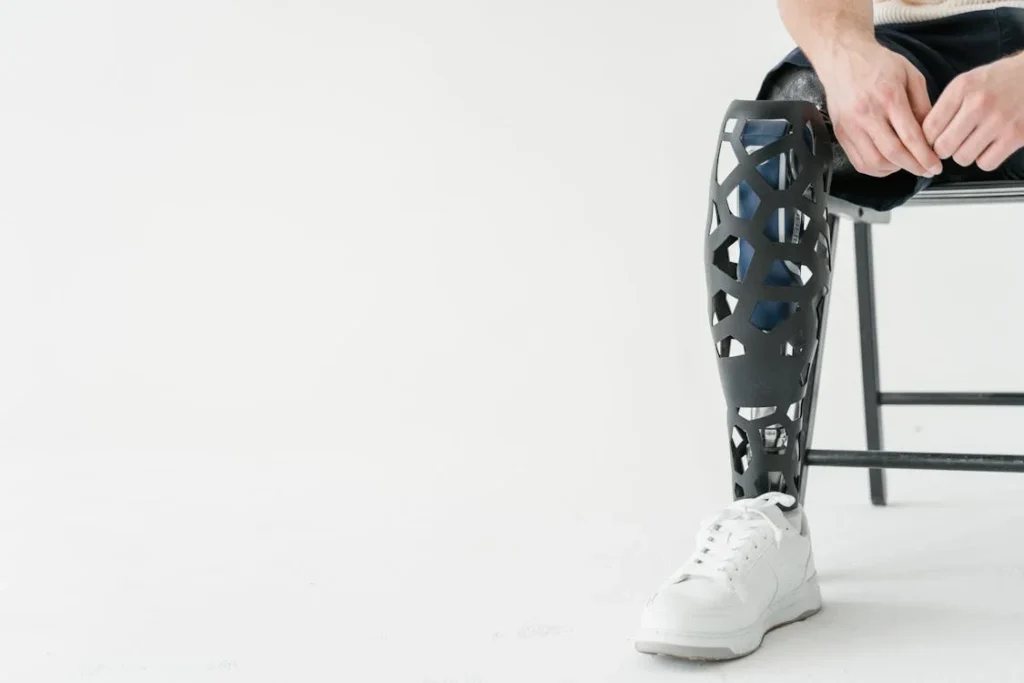
The Influence of Prosthetic Foot Type on Gait Deviations
One of the most often overlooked causes of gait deviations lies in the type of prosthetic foot being used. While socket fit and alignment are essential, the choice of foot—its stiffness, flexibility, design, and energy return—has a major influence on how you walk, how your body reacts to the ground, and how natural your movement feels.
Choosing the wrong foot, or one not suited to your activity level and body mechanics, can lead to subtle but persistent gait problems.
That’s why understanding how different prosthetic foot types affect your gait is critical to fixing long-term deviations and finding lasting comfort.
Not All Prosthetic Feet Are the Same
There’s a wide range of prosthetic foot options available, and each one behaves differently. Some are designed to be rigid and stable, giving support for standing or simple walking. Others are flexible and dynamic, meant for more active users who walk longer distances or tackle different surfaces.
There are also feet with shock absorption, split toes for uneven ground, and even microprocessor-controlled ankles that adjust on the fly.
If the foot is too stiff for your weight or activity level, it can prevent proper rollover during walking. This makes your step feel “flat” and may cause you to lift your hip unnaturally or land harder on your sound leg.
Over time, you might develop vaulting or hip hiking as a way to swing the foot through, which wastes energy and leads to imbalance.
If the foot is too soft, it may not offer enough push-off during toe-off. This can lead to short steps, uneven pace, and early fatigue.
Your natural leg may then begin doing more work than it should, setting you up for joint pain and muscle strain.
Feet with too much or too little flexibility in the toe or heel region can also change the timing of your gait. If the heel compresses too much, your knee might feel unstable at heel strike.
If the toe is too stiff, you might roll over it too fast or too slow. These are the kinds of issues that often feel “off” but aren’t easily seen without careful analysis.
How to Know If Your Prosthetic Foot Is Contributing to Gait Problems
Often, users blame their socket fit or walking habits for issues that are actually linked to their foot type. If your prosthesis feels well-fitted and you’ve built strength, but you still notice persistent gait deviations—especially during push-off, turning, or walking on slopes—it may be time to assess the foot itself.
Common signs that your foot might not be the right match include a constant feeling of being pitched forward or backward, reduced balance on uneven surfaces, or frequent tripping even when you’re paying close attention.
You might also feel that you’re not getting any “bounce” when walking, or that your pace is slower than expected for your fitness level.
Another clue lies in how much you have to think about walking. If you’re constantly adjusting your stride, overusing your upper body to stay balanced, or shifting weight unnecessarily, it may be your prosthetic foot doing too little—or too much—work.
Finding the Right Foot for Your Needs
The right foot is the one that matches your lifestyle, body weight, limb length, and goals. For someone who mostly walks indoors and wants stability, a simple single-axis or solid ankle cushion heel (SACH) foot might be enough.
But for someone who walks longer distances, climbs stairs, or wants more responsive movement, a dynamic-response carbon foot may be more appropriate.
There’s also the question of ankle motion. Some prosthetic feet allow for a small degree of ankle movement, which can improve balance on slopes or uneven terrain. Others have no ankle motion at all, which may feel more stable but reduce adaptability.
More advanced feet, like hydraulic or microprocessor-controlled feet, can adjust the angle or resistance in real time.
These are especially helpful for users who walk on varied terrain or have very active lifestyles. However, they require more maintenance, training, and in some cases, come at a higher cost.
When you try a new foot, your prosthetist should give you time to walk, turn, and test it under different conditions. Pay close attention to how your body feels—not just in your limb, but in your back, shoulders, and hips. A foot that’s working with your body should feel like an extension of you, not something you’re constantly managing.
At Robobionics, we often see users transform their gait with nothing more than a change in foot type. Sometimes, it’s a slight upgrade. Other times, it’s a completely different style. But what matters is that the foot matches the user—not the other way around.
Keep Reviewing as You Evolve
Your ideal foot may also change over time. As you get stronger, more active, or your goals shift, the foot that worked six months ago might start holding you back.
That’s why regular reviews with your prosthetist are important—not just for alignment and socket fit, but for foot performance.
Don’t be afraid to ask questions about foot options. Technology in prosthetics evolves quickly, and new designs may offer benefits you didn’t have access to before.
You might find a foot that gives you better balance, more confidence on stairs, or a smoother step—all of which help fix or prevent gait deviations.
Remember, your prosthetic foot is the base of every step you take. When it’s right, everything above it works better. And when it’s wrong, even strong muscles and good alignment can’t fully compensate.
Conclusion
Fixing gait deviations in prosthetic users isn’t just about correcting the way someone walks—it’s about restoring ease, comfort, and confidence in every step. It’s about empowering you to move through life freely, without discomfort or self-doubt holding you back. Whether it’s adjusting alignment, choosing the right prosthetic foot, strengthening key muscles, or simply being more mindful during your daily routine, each element works together to support smoother, more natural movement.
At Robobionics, we believe gait is more than mechanics—it’s your connection to the world. It’s how you greet a friend, explore a new place, or stand proudly in a moment that matters. And when that connection is strong, life opens up in powerful ways.
Every deviation has a cause, and more importantly, every deviation has a solution. The journey to better gait isn’t about perfection—it’s about progress. And that progress is always within reach when you pair the right tools, the right team, and the right mindset.
You deserve to walk with ease, to move with balance, and to live without compromise.
And we’re here—every step of the way.



